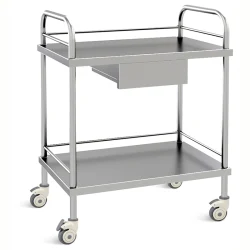Choosing the Right Cart for Your Needs: A Complete Guide
2024-09-29
Carts are an essential tool in many environments, from homes and offices to warehouses and hospitals. They help transport goods, equipment, or supplies efficiently, reducing the risk of strain and injury. With so many options available, it can be overwhelming to select the right cart for your specific needs. This guide will help you understand the different types of carts and key factors to consider when choosing one.
1. Types of Carts
Depending on the intended use, carts come in various designs and sizes. Here are some of the most common types:
- Utility Carts: Versatile and often found in kitchens, offices, and homes, utility carts are perfect for light to medium loads. They come in various materials, including plastic, stainless steel, and metal. Ideal for moving supplies, tools, or food, these carts typically have multiple shelves for organized transport.
- Platform Carts: These heavy-duty carts are designed to carry large or bulky loads. Platform carts often feature a flat base with four wheels and a handle for easy maneuverability. They’re commonly used in warehouses, retail environments, and industrial settings to move equipment, boxes, or heavy items.
- Tool Carts: Specifically designed for mechanics or technicians, tool carts come with drawers or shelves to store and organize tools. They make it easy to transport tools around a garage or workshop while keeping everything within reach.
- Medical Carts: In healthcare settings, medical carts are used to store and transport medical supplies, medications, and equipment. Some are equipped with locking mechanisms to ensure the security of medications or sensitive equipment.
- Garden Carts: Perfect for outdoor use, garden carts help in carrying soil, plants, or gardening tools. They often have durable, weather-resistant materials and sturdy wheels that can handle rough terrain.
2. Key Features to Look For
When selecting a cart, it’s important to consider key features that will affect its usability and durability. Here are some things to keep in mind:
- Weight Capacity: One of the most critical factors to consider is how much weight the cart can carry. Exceeding the weight capacity can damage the cart and make it unsafe to use. Make sure to select a cart that can handle the load you intend to transport regularly.
- Material: The material of the cart will determine its durability, weight, and ease of maintenance. Plastic carts are lightweight and easy to clean, while metal carts (like stainless steel) offer more durability and resistance to wear and tear.
- Wheels: Pay attention to the type and size of wheels. Larger wheels are better for uneven or rough surfaces, while smaller wheels are suitable for smooth, indoor environments. Swivel wheels offer easier maneuverability, especially in tight spaces.
- Shelving and Storage Options: Depending on what you plan to carry, the number of shelves, bins, or drawers in the cart can be a significant factor. Some carts feature removable or adjustable shelves, providing more flexibility for different-sized items.
3. Factors to Consider Based on Use
To ensure you get the best cart for your needs, consider how and where you’ll be using it:
- Indoor vs. Outdoor Use: For outdoor use, like in a garden or construction site, you’ll need a cart that can withstand weather conditions and uneven surfaces. Indoor carts typically don’t need to be as rugged, but their wheels should be appropriate for the flooring type to avoid damage.
- Load Type: If you’re moving small, lightweight items like office supplies or cleaning products, a standard utility cart will suffice. For heavier or bulkier items like machinery or large boxes, you’ll need a more robust cart, such as a platform or industrial cart.
- Storage Space: If space is a concern, opt for foldable or compact carts that are easy to store when not in use. Some carts also feature collapsible shelves or frames, making them ideal for tight spaces.
4. Maintenance and Safety
Keeping your cart in good condition ensures it will last longer and remain safe to use. Regularly inspect the wheels, handles, and shelves for any signs of wear or damage. Lubricate any moving parts as needed, and clean the cart to prevent rust or dirt buildup.
Conclusion
Carts are invaluable tools for making transportation easier in many settings. By understanding the different types and key features, you can choose the right cart for your specific needs. Whether you need a lightweight utility cart for your home or a heavy-duty platform cart for industrial use, selecting the right one will make your tasks more efficient and safer.



